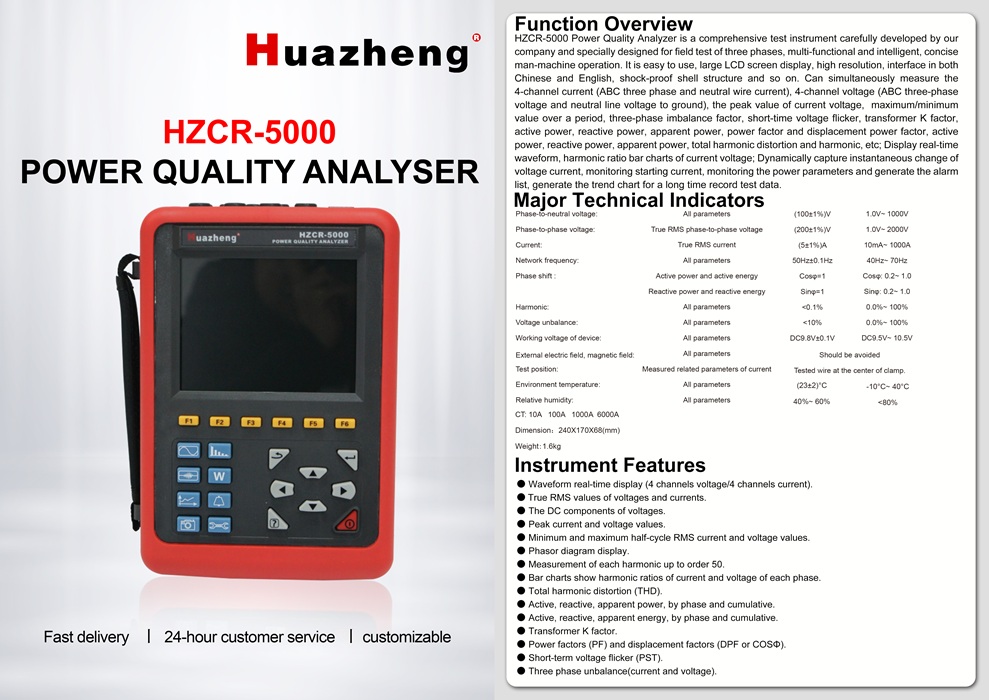Time: 2025-11-10 Author: 铧正 Click: 162 Time
Power quality analyzers are essential instruments for assessing power quality in various systems. They play a crucial role in identifying and diagnosing power-related problems, ensuring the efficient and reliable operation of power systems. These analyzers measure a wide range of parameters, including voltage, current, frequency, harmonics, and power factor, providing a comprehensive overview of power quality.
Power quality refers to the characteristics of the electricity used by equipment and the degree to which it meets required standards. Poor power quality can lead to equipment failure, increased energy costs, and even damage to sensitive electronic equipment. In this context, power quality analyzers become particularly important. By monitoring and analyzing electrical parameters, they can help accurately locate interference such as voltage drops, surges, transients, and harmonics.

HZCR-5000 Power quality analyser adopt DSP + ARM double processor architecture, DSP is use for data collection and the processing of algorithm, the ARM is use for the communication protocol and the man-machine interface processing; Analog signal acquisition is by 2 pieces AD7655 of ADI company. Resolution for AD7655 is 16 bit and it is 4 channel synchronous sampling. The highest sampling rate can reach 1 MSPS, to ensure the accuracy of the channel and the information integrity, and wouldn’t miss any transient changes in the grid, can more accurate to detect the transient waveform rising and dropping drastically, and waveform instantaneous interrupt; DSP working frequency is over 200 MHZ, to be able to timely monitoring of the power grid and dynamically adjust the sampling frequency to realize synchronization of power frequency and sampling frequency; Using a 5.6 -inch LCD color screen display, a resolution of 640 dots x 480 dots, with different display color difference between the parameters of phase, waveform, vector diagram, harmonic ratio, the user can be more efficient and more intuitive understand the state of power grid parameters. Built-in flash memory can store 60 group of screenshots at the same time, 150 groups of capture transient voltage/current waveform figure, and 12800 groups of alarm list. Starting current detection model can continuously capture starting current waveform for 100 s. Built-in 2G memory card to store the trend curve record, simultaneous recording 20 parameters (can choose according to need) collect data for once every five seconds, trend curve records can be stored for 300 days.
Power Quality Analyser also named: Intelligent Three Phase Power Quality Analyser, Multifunctional Power Quality Analyser, which simultaneous with the functions of harmonic analyser, phase volt-ampere meter, electric parameter tester. It apply to electricity industry, petrochemical, metallurgy, railway, mining enterprises, scientific research institution, metrological department. Especially suitable for comprehensive analysis and diagnosis on all the voltage, current, power, power, harmonic, phase electric parameters.
Operating a power quality analyzer typically involves connecting the device to the electrical system under test. Once connected, it collects data over a specified period and then analyzes the data to identify any anomalies. Many modern analyzers are equipped with advanced features such as data logging, real-time monitoring, and the generation of detailed reports. This information is crucial for engineers and technicians who need to make informed decisions about power management and system improvements.
In industries with extremely high power quality requirements, such as manufacturing, telecommunications, and healthcare, the use of power quality analyzers is crucial. It not only helps maintain the integrity of the power system but also contributes to improved energy efficiency and cost savings. By ensuring optimal power quality, businesses can improve operational reliability and extend equipment lifespan.
In short, a power quality analyzer is an essential tool for anyone looking to maintain high standards of power quality, ultimately improving performance and reducing operational risks.